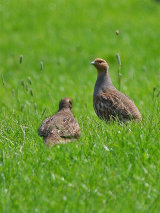- Home
- About this site
- Birds
- Divers & Grebes
- Petrels & Shearwaters
- Boobies, Gannets & Cormorants
- Bitterns & Herons
- Ibises & Spoonbills
- Wildfowl
- Birds of Prey
- Gamebirds
- Rails, Crakes & Coots
- Waders
- Skuas, Gulls & Terns
- Auks
- Pigeons & Doves
- Owls
- Kingfishers, Bee-eaters, Rollers & Hoopoes
- Woodpeckers & Wrynecks
- Larks
- Swifts, Martins & Swallows
- Pipits & Wagtails
- Wrens, Dippers, Waxwings & Accentors
- Chats & Thrushes
- Warblers & Flycatchers
- Tits & Allies
- Nuthatches & Treecreepers
- Shrikes & Orioles
- Crows & Starlings
- Sparrows
- Finches
- Buntings
- Vagrants & Rarities
- Insects
- Arthropods
- Slugs & Snails
- Mammals
- Reptiles & Amphibians
- Landscapes & Scenes
- My Flickr Gallery
- Useful Links
- Contact us
Gamebirds
Grouse.
Grouse are medium to large-sized ‘gamebirds’, somewhat partridge-like, with rounded bodies, short, broad wings and small heads with stout, arched bills. They feed on shoots, buds and seeds of small shrubs and herbs.
Red grouse are especially associated with heather; black grouse prefer a mixture of heather, rushy areas, rough grass and woodland edge, while capercaillies survive best where pine woodland intermingles with boggy heath and plentiful supplies of bilberry, cranberry and crowberry.
For more information click here
Partridges, Pheasants and Quail.
Small, medium and large-sized gamebirds, from the tiny quail to the long-tailed, large-bodied pheasants, all with short, curved bills, small heads, rounded bodies and short legs.
Most are social birds, often found in family groups, but in the pheasants the males have little to do with the family. Most are resident, but quails are long-distance migrants, spending the winter in Africa.
For more information click here
Text (c) RSPB, used with permission
Grouse are medium to large-sized ‘gamebirds’, somewhat partridge-like, with rounded bodies, short, broad wings and small heads with stout, arched bills. They feed on shoots, buds and seeds of small shrubs and herbs.
Red grouse are especially associated with heather; black grouse prefer a mixture of heather, rushy areas, rough grass and woodland edge, while capercaillies survive best where pine woodland intermingles with boggy heath and plentiful supplies of bilberry, cranberry and crowberry.
For more information click here
Partridges, Pheasants and Quail.
Small, medium and large-sized gamebirds, from the tiny quail to the long-tailed, large-bodied pheasants, all with short, curved bills, small heads, rounded bodies and short legs.
Most are social birds, often found in family groups, but in the pheasants the males have little to do with the family. Most are resident, but quails are long-distance migrants, spending the winter in Africa.
For more information click here
Text (c) RSPB, used with permission
- Other galleries:
- Divers & Grebes
- Petrels & Shearwaters
- Boobies, Gannets & Cormorants
- Bitterns & Herons
- Ibises & Spoonbills
- Wildfowl
- Birds of Prey
- Gamebirds
- Rails, Crakes & Coots
- Waders
- Skuas, Gulls & Terns
- Auks
- Pigeons & Doves
- Owls
- Kingfishers, Bee-eaters, Rollers & Hoopoes
- Woodpeckers & Wrynecks
- Larks
- Swifts, Martins & Swallows
- Pipits & Wagtails
- Wrens, Dippers, Waxwings & Accentors
- Chats & Thrushes
- Warblers & Flycatchers
- Tits & Allies
- Nuthatches & Treecreepers
- Shrikes & Orioles
- Crows & Starlings
- Sparrows
- Finches
- Buntings
- Vagrants & Rarities



